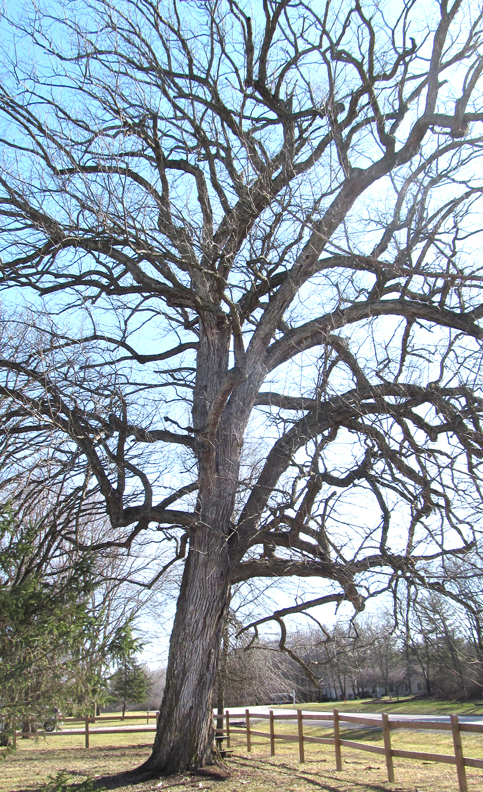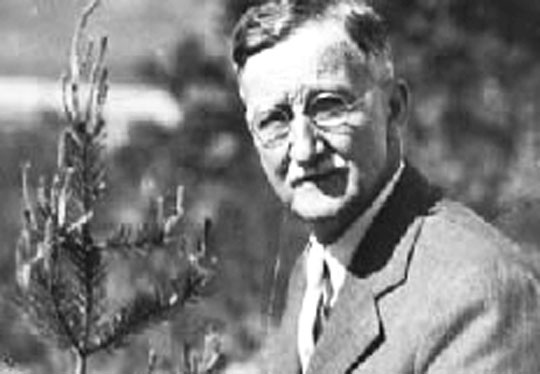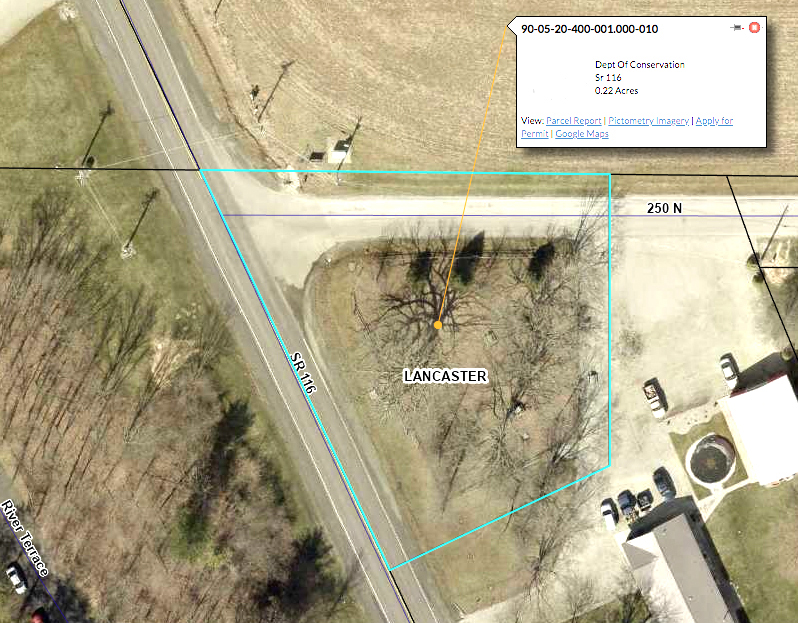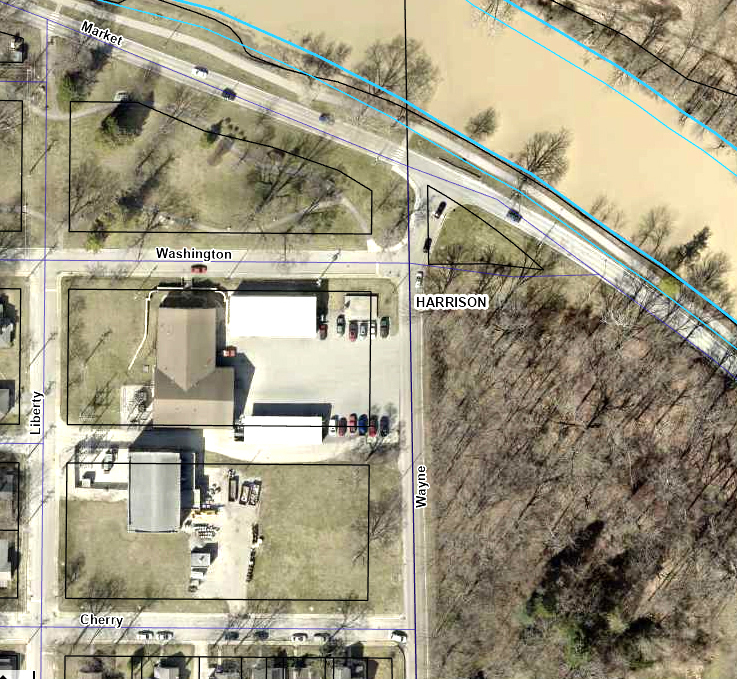The story of Wells County’s unique Deam Oak gets an update
By MARK MILLER
How many Deam Oaks are there?

The answer to that question is not as easy as it would seem. The generally accepted belief has been there is only the one sturdy but aging oak tree at the corner of Ind. 116 and Wells County Road 250 North. And that has been almost — almost — undeniably true for more than 100 years. But things change.
A brief history
The approximately quarter-acre plot’s centerpiece at that location is a unique oak tree named after Charles C. Deam. It was discovered by another Bluffton scientific luminary, E. B. “Bruce” Williamson and his father Lent on Oct. 4, 1904. Accomplished botanists in their own right, they did not recognize the tree’s specific species, so Bruce Williamson took it to his friend “Charlie” who operated a drug store in downtown Bluffton. (There is an entirely additional story in how Williamson had introduced his friend to botany and horticulture. Williamson, of course, obtained significant fame for his iris hybrids at Longfield Farm — as well as his dragonfly collection and expertise — while Deam would become Indiana’s first State Forester.)

Deam in turn, forwarded the specimens to Dr. William Trelease, a professor at Washington University in St. Louis. It required many years of retaking specimens and study before it was determined, in 1917, to indeed be a new variety, officially a cross between a chinquapin oak and a white oak, both of which had been growing nearby. The official name was determined to be a “Deam Oak,” even though it was discovered by the Wiliamsons.
Local historian Alan Daugherty, who has been working on a history of Williamson (which includes a chapter on Deam), reports that Williamson supported the decision, describing it as “typical of his generous personality.”
Meanwhile, Deam’s reputation in the field was growing, particularly with the publication of his book, “Trees of Indiana” in 1912 which was widely acclaimed. He produced revised editions in 1921, 1931 and 1953.
In 1925, while serving as the Indiana State Forester, Deam discovered that the farmer who owned the land on which the tree stood was planning to cut it down in order to gain more tillable acres. After failing to convince him of the tree’s value, he purchased the small plot, — officially 0.22 acre — from the farmer and his wife, William and Merle North Brown. The sale was reported in the Bluffton Evening News on July 6, 1925 with a sale price of $50 (equivalent to about $860 today).
Deam immediately deeded the parcel to the state, with the stipulation that it be used for “park purposes.” It became known as the “Deam Oak Monument Forest” and its maintenance eventually fell under the auspices of the nearby Ouabache State Park.
Deam went on to even greater fame in the scientific community. He corresponded regularly with a number of notable universities and arboretums and regularly sent specimens, seedlings and seeds to, for example, the Arnold Arboretum in Boston (associated with Harvard University), the New York Botanical Gardens and the Missouri Botanical Gardens. In 1987, Robert Kriebel wrote a biography: “Plain ol’ Charlie Deam, Pioneer Hoosier Botanist.”
Almost 100 years later, the tree, depending who is asked, is “doing well,” “showing signs of distress,” or “it’s just an old tree.” Attempts to grow additional Deam Oaks from the tree’s acorns, which are produced every other year, have always reportedly been unsuccessful. When a sapling has sprouted, it proved to be either a chinquapin or a white oak, but never a true Deam Oak, at least to local knowledge. (More on that later.) Hence, the only way to propagate the tree, it has been widely believed, is through a grafting process that requires technical knowledge and a bit of luck.
The grafters
In February, 2011, George Hibben from the Arnold Arboretum reached out to the Bluffton mayor’s office via an email: “I am gathering information about the Deam Oak and Charles Deam. I would like to contact the ‘caretaker’ of the tree and park. Might you be able to direct me (to the correct person)?” Brenda Jackson gave the inquirer Doug Sundling’s email address. Sundling, who was at the time working for the city in several engineering and consulting capacities, is also a naturalist in his own right. The two hit it off. In a later email, Hibben wrote “it would appear that by chance I have found the person in the Bluffton area most knowledgeable and interested in the work of Charlie Deam and the preservation of the Deam Oak!”

Working with Bob Greiner, then manager of Ouabache, Sundling obtained the assistance of Brad Rody, district forester for the state. The time of year for collecting “scions” — the term for a small shoot or twig from a plant cut for grafting — was upon them. So the two would collect 75 “Quercus Deamii” specimens from the tree on Ind. 116 and ship them via overnight FedEx to Boston on March 2, 2011. They were carefully grafted by Jack Alexander at the arbetoreum who, Sundling has learned, is still on the job.
The following September, Hibben reported that 18 of the grafted Deam Oaks had survived the summer and had “8 to 12 inches of new growth.” Sundling sent another shipment of scions the following March and then in April, 2012, traveled to Boston and returned with 16 grafted trees. He put each seedling in its own pot and set them in a sheltered open space on the north side of his Bluffton residence.
Although he had thought he’d mentioned the developments to the News-Banner, his records include no newspaper clippings “which I certainly would have kept,” he said. Additionally none of the newspaper’s staff have any recollection of the knowledge.
While he did not check on the saplings’ development daily; he figured they would need at least a year or two to mature enough for final transplanting. He discovered that growing trees is “more of an art than a science,” he explained.
“I did kind of keep it quiet,” Sundling reflected. He was concerned as to whether someone might try to steal a specimen, particularly after he’d re-planted them in several locations.
While a few local people were aware of the project, such as Greiner who retired in 2011, current Ouabache naturalist Jody Heaston was not. “I’d heard some rumors,” she told the News-Banner, but nothing definitive.
“I think it is good now to let people know about it.” Sundling said. “It’s an important part of our local history and heritage.” And the trees are at the point that they are fairly sturdy and should continue to grow.
Where are they?
In April 2013, Sundling received three more seedlings from the Arnold Arboretum. By 2014, what seedlings had survived to this point were ready to find a permanent home.
On April 18, he planted two seedlings at the Deam Oak site on Ind. 116. One survives.
On April 21, he planted six seedlings in the open green space west of the fire tower in the state park. They did not do well there; he eventually tried to move four survivors to a “partially sunny spot,” he said, in a wooded parcel of land he owns just south of the Wabash River. None would survive.
He did not record the exact date on which he planted three seedlings in a small triangular city-owned parcel at the end of East Washington Street where it ends at Wayne Street, which is also along River Road.
This small plot is located at the north edge of what once was the “Deam Arboretum,” about 20 acres of woods, the trees almost all of which were planted by Charlie Deam and his wife Stella who lived in the two-story white frame house at the southern edge of the property. Two survive. The city had been informed of the plantings.
“I had asked the mayor (Ted Ellis, at the time) for permission and then of course let maintenance — Randy Peeper — know so they’d be careful mowing,” Sundling added.
So how many are there?
At present, that adds up to four known Deam Oak trees in Wells County. Are there others?
George Hibben, Sundling’s original contact, who was actually a retired volunteer at the Arnold Arboretum, wrote an article in the fourth-quarter, 2012, edition of the “Arnoldia,” a quarterly magazine published by the arboretum, about the Deam Oak and the efforts he was making — with the assistance of what he termed the “Indiana Dream Team” — in “clonally propagating the original tree.” Several of those grafted plants, he continued, would be grown in the “Arboretum’s Living Collection.” Sundling recently re-connected with Hibben, now a still sharp-minded 92 years old. One still survives.
As noted earlier, all of Deam’s (and others’) recorded attempts to grow additional trees from the original tree’s acorns failed — those seedlings that survived were either a chinquapin or white oak. However, in one of his revisions to his “Trees of Indiana” book, Deam reported that he had shipped numerous seeds to other botanical gardens, some of which reported success.
Additionally, Hibben’s article also revealed that Deam had sent acorns to the Arnold Arboretum in 1916, from which they were successful in producing an oak tree which their records (assumed to be scientific) list as a Deam Oak. The article also reported that in 1908, Deam had sent some acorns of the tree (yet to be officially designated as a unique hybrid) to the Parks Department of Rochester, New York. Two plants from those acorns made their way to the Arnold Arboretum. “It is likely that they were grown from seed distributed by Charles Deam,” the article states. One of them stood about 66 feet tall in 2012 on the arboretum grounds.
“I cannot say either ‘yes’ or ’no’ that those are true Deam Oaks,’ Sundling said. “It is something I’d like to get a definitive answer on.”


There is also a curious entry that Alan Daugherty had found in a 1911 annual report of the State Board of Forestry, written by Deam, in which he describes a tree of the same specific details found Oct. 9, 1904 (the other discovery cites the date as Oct. 4) by E.B. Williamson (his father not being mentioned in this version), located “on a slope 2 miles northwest of Bluffton” (there is certainly no slope to the current Deam Oak site, and that’s one mile closer than the original report) and that it had been cut down a few years later.
Sundling had not seen this tidbit, and found it curious.
“Charlie was so meticulous in his notes and records, so I can’t explain it.” he said. “But he wasn’t always as meticulous about others things.” This may just be part of some of the mysteries that surround the tree and its legacy, he concluded. He also speculated that the locale cited in this version would put it on the property now occupied by the IMI stone quarry, which had and has some sloping terrain.
“I wonder if just that tree, that Deam Oak, was cut down or if the area was cleared due to development — such as the stone quarry,” he told the News-Banner. “There must be something conducive in the area along the Wabash River there that encouraged white and chinquapin oaks to interbreed and create Deam Oaks.”
And that thought leads to further speculation, even if it might be a bit tongue-in-cheek: It may be no coincidence that this roadway was not yet designated a state highway at the time, but was known then as “Lovers Lane.”
Are there more out there?
miller@news-banner.com



